2022届高考英语二轮复习专题冠词1课件(28张PPT)
文档属性
| 名称 | 2022届高考英语二轮复习专题冠词1课件(28张PPT) | 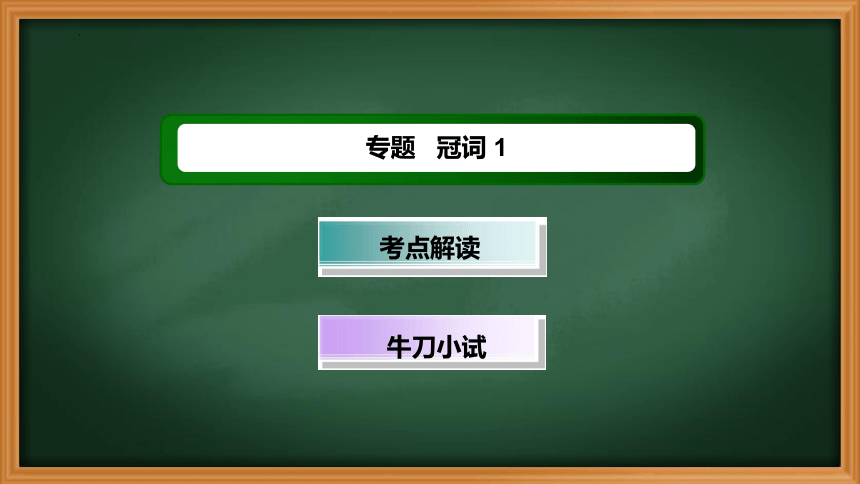 | |
| 格式 | zip | ||
| 文件大小 | 604.5KB | ||
| 资源类型 | 教案 | ||
| 版本资源 | 人教版(2019) | ||
| 科目 | 英语 | ||
| 更新时间 | 2022-04-16 23:11:22 | ||
图片预览

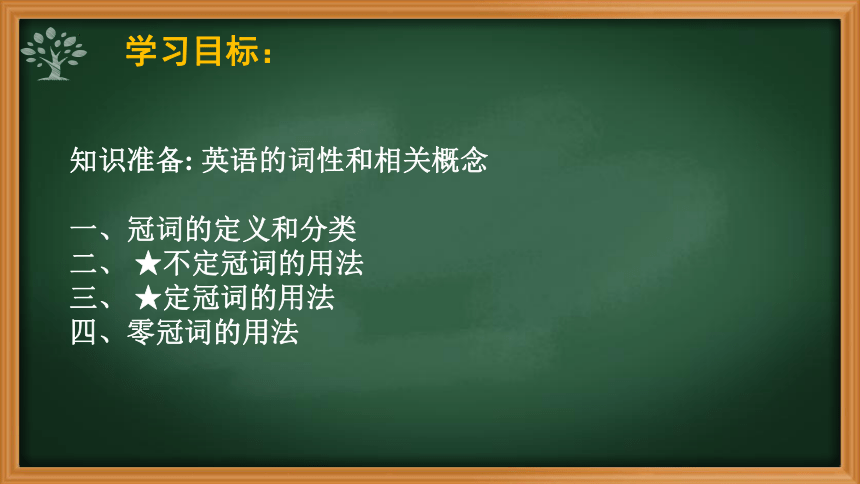
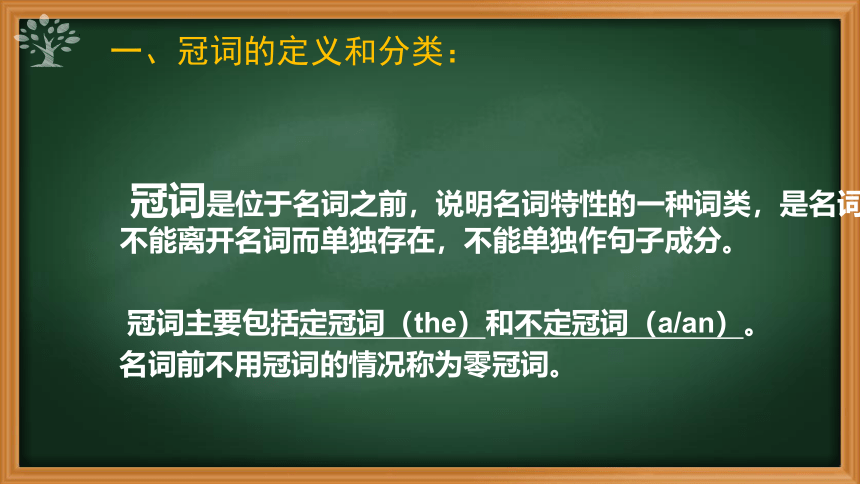
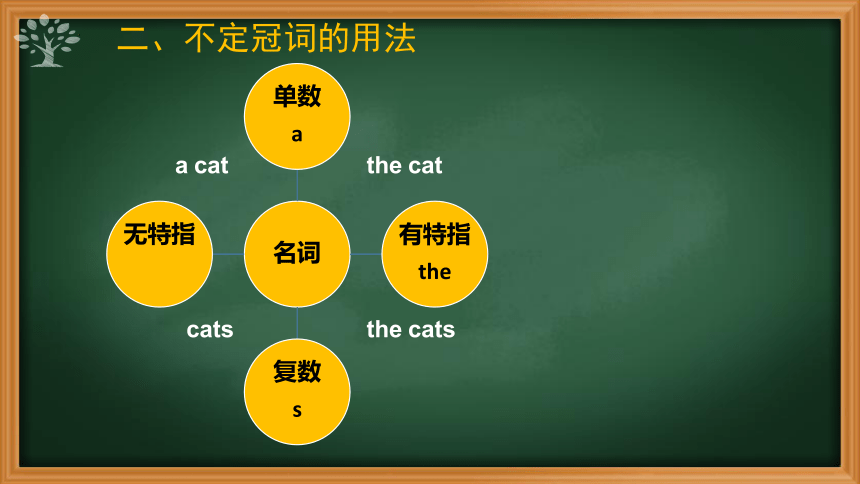


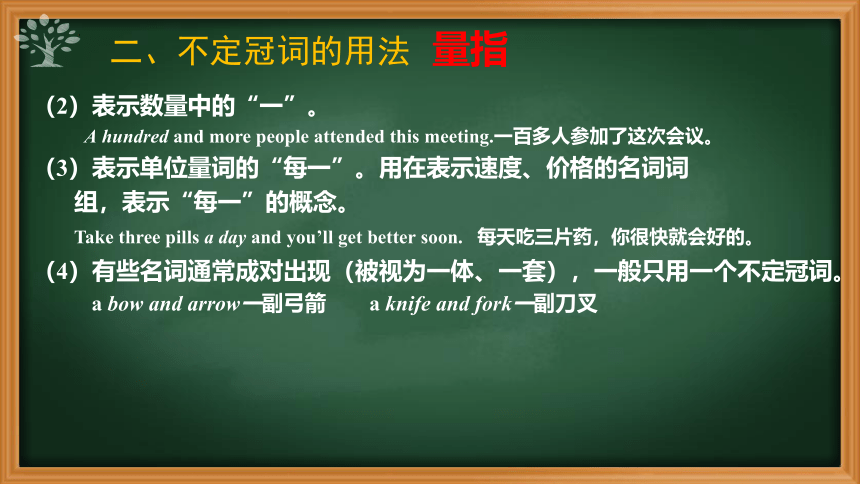

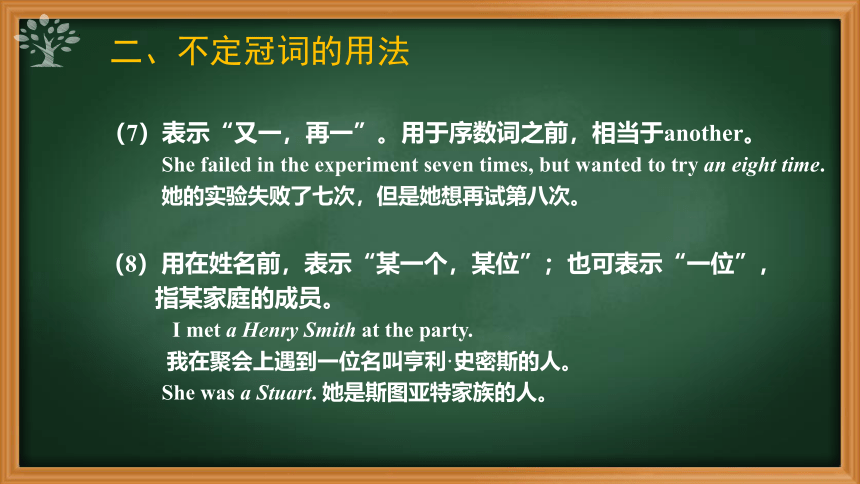
文档简介
(共28张PPT)
考点解读
牛刀小试
专题 冠词 1
知识准备: 英语的词性和相关概念
一、冠词的定义和分类
二、 ★不定冠词的用法
三、 ★定冠词的用法
四、零冠词的用法
学习目标:
冠词是位于名词之前,说明名词特性的一种词类,是名词的一种标志,不能离开名词而单独存在,不能单独作句子成分。
冠词主要包括定冠词(the)和不定冠词(a/an)。
名词前不用冠词的情况称为零冠词。
一、冠词的定义和分类:
名词
单数
a
有特指
the
复数
s
无特指
a cat
the cat
cats
the cats
二、不定冠词的用法
用于可数名词前,常常表示不定指代。
通常用于类指或量指,以及某一些固定搭配。
二、不定冠词的用法
(1)表示泛指的某人、某物。在可数名词前,表示一类人或
者物。不明确指出具体的人或物,只说明大体情况。
A dictionary is very necessary for me. 词典对我来说是必备的。
A child should have more free time to think.
孩子应当有更多的自由时间进行思考。
二、不定冠词的用法
类指
(2)表示数量中的“一”。
A hundred and more people attended this meeting.一百多人参加了这次会议。
(3)表示单位量词的“每一”。用在表示速度、价格的名词词
组,表示“每一”的概念。
Take three pills a day and you’ll get better soon. 每天吃三片药,你很快就会好的。
(4)有些名词通常成对出现(被视为一体、一套),一般只用一个不定冠词。
a bow and arrow一副弓箭 a knife and fork一副刀叉
量指
二、不定冠词的用法
(5)用在物质名词前,表示“一阵、一份、一类、一场”等。
A light snow happened in Qingdao. 青岛下了一场小雪。
(6)不可数名词前加不定冠词。不可数名词如 education 教育、
history历史等在表述其某一部分或某一方面的内容、概念时,
前面常加不定冠词。
receive a good education接受良好的教育
have a long history拥有悠久的历史
二、不定冠词的用法
量指
(7)表示“又一,再一”。用于序数词之前,相当于another。
She failed in the experiment seven times, but wanted to try an eight time.
她的实验失败了七次,但是她想再试第八次。
(8)用在姓名前,表示“某一个,某位”;也可表示“一位”,
指某家庭的成员。
I met a Henry Smith at the party.
我在聚会上遇到一位名叫亨利·史密斯的人。
She was a Stuart. 她是斯图亚特家族的人。
二、不定冠词的用法
不定冠词表示微弱的“一”的概念。
a/an泛指同类事物中的“任何一”;
one则强调数目概念,表示“一个”,不是“两个,三个”
Can a robot do such work 机器人能做这种工作吗
No, only people can do it. 不能,只能靠人来做。
Can one child finish the job 这件事,一个孩子能干得了吗?
No, at least two children can. 一个孩子干不了,至少得两个。
二、不定冠词的用法
二、不定冠词的用法—固定搭配
具有动作意义的名词在与have、take、make、give等构成短语, 表示“做一做” have a look看一看 have a bath洗个澡 have a go试一试
give a whistle吹口哨 give a smile微笑 take a rest休息一下
take a bath洗个澡 make a choice做出选择 make a decision做出决定
动词同源的名词前加不定冠词 smile an attractive smile 笑得迷人 die a glorious death 光荣牺牲 sleep a sound sleep
睡得很香
fight a hard fight 进行艰苦的斗争 dream a sweet dream 做个甜美的梦 live a happy life
过着幸福生活
二、不定冠词的用法—固定搭配
因为爱着你的爱,苦着你的苦
与一些常用动词构成搭配 pay a visit拜访 take a seat坐下 get in a word插话
make a face做鬼脸 make a living谋生 make a mistake犯错误
make an effort努力 make an apology道歉 make a speech做演讲
make it a rule 形成制度 give a lecture 举行讲座 have a meeting
开会
do a good deed做好事 catch a bad cold患重感冒 have a good time过得偷快
have a match比赛 make a promise许诺 give sb.a hand给某人帮忙
keep an eye on照看,密切注视 go out for a walk 外出散步
have a cough/ fever 咳嗽/发烧 have a headache 头疼 take an interest in
对……感兴趣
二、不定冠词的用法—固定搭配
与时间和方式有关的短语 as a rule通常 in a word总之 in a moment立刻
as a result 因此 ina hurry急匆匆地 once in a while偶尔
a moment ago刚才 for a time暂时,一度 all of a sudden突然
half an hour半个小时 after a while一会儿后 twice a week每周两次
once upon a time从前 as a matter of fact事实上 with a smile 微笑着
at a high speed高速的 after a time一段时间之后 just a minute/moment 一会儿
a day or two ago一两天前 in a special way 以特殊的方式
二、不定冠词的用法—固定搭配
三、定冠词的用法—类指
(1)定冠词用于可数名词前,表示一类人或东西。如:
The horse is a useful animal. 马是一种有用的动物。
(2)定冠词用于某些名词或者形容词前,表示一类人,
一个民族,阶级或阶层。如:
the Chinese 中国人 the rich 富人
the dead 死者 the deaf 聋人
(3)表示独一无二的或被认为是唯一东西的名词前。
the sun 太阳 the earth 地球 the world世界
(4)表示特指的人或物的名词前(熟知或心照不宣的人或物);
或者是上文提到的人或物。
Please close the door.请把门关上。
My uncle works at a university. The university is in Qingdao.
我叔叔在大学工作。他工作的大学在青岛。
三、定冠词的用法—特指
(5)某些专有名词前:海洋、河流、山脉、群岛、报纸、杂志、
书籍、会议、条约、星座、船只、舰队、铁路、飞机、三军、
历史朝代、某些国名和组织机构等的名词前。
the Air Force 空军
the Lord 上帝
the Pacific Ocean 太平洋
the Philippines 菲律宾群岛
the People’s Republic of China 中华人民共和国
三、定冠词的用法—特指
(6)用在表示方向、方位的名词前。在介词短语中,方向、方
位名词前要用定冠词。
They lived in a small town in the South.
他们住在南方的一座小镇上。
★在某些“方位词+介词”结构中,方位词前不用冠词:
from south to north从南到北
north by east北偏东
三、定冠词的用法—特指
(7)定冠词在play后和乐器连用
play the piano弹钢琴 play the flute吹长笛
(8)用在姓氏的复数形式前,表示此姓氏的“一家人”或“夫
妇俩”。
The Greens often go to the suburbs on Friday.
格林一家周五常去郊区。
(9)定冠词用于有词组或者定语从句修饰的名词前。
He is investigating the cause of the fire.
他正在调查这场大火的原因。
三、定冠词的用法—其他
(10)形容词或副词的最高级、序数词前面;
也可以用于only、main、sole、same、present、usual、
wrong、ultimate、right、principal等修饰词前。
It was the best of times. It was the worst of times.
那是最美 好的时代,也是最糟糕的时代。
三、定冠词的用法—其他
三、定冠词的用法—固定搭配
用在“by+the+计量单位名词”结构中 The employees are paid by the month. 雇员的工资是按月支付的。
用在“越……越”结构中 The more we get together,the happier we’ll be. 我们相处得越久,我们就越快乐。
由短语或从句修饰的名词前 The key to the safe is lost. 保险箱的钥匙丢了。
The problem to the matter is easy to solve. 这件事的问题很容易解决。
常用定冠词的地名、组织名 the USA 美国 the UK 英国 the Great Wall 长城 the West Lake
西湖
the Yellow River 黄河 the UN 联合国 the Summer Palace 颐和园 the WTO
世界贸易组织
the Yangtze River 长江 the Palace Museum 故宫博物院 the Himalayas 喜马拉雅山 the History
Museum
历史博物馆
三、定冠词的用法—固定搭配
与时间相关的短语 the past过去 all the time 一直
the next day第二天 in the day在白天
the day before yesterday前天 at the same time同时
in the morning在上午 in the1990’s/1990s在20世纪90年代
in the middle of在……的中间 at the age of在……岁时
at the end of在……结束时 all the year round一年到头
三、定冠词的用法—固定搭配
与方位相关的短语 at the foot of在……的脚下 in the sky在天空中
in the world在世界上 on the way to在去……的路上
in/on the street在街道上 in/on/to the east of在……的东部
at the back of在……的后边 on the right/ left of在……的右/左边
on both sides of在的两旁 at/in/on the corner of 在……的角上
in the middle of在……的中间 at the top/ bottom of在……的顶/底部
三、定冠词的用法—固定搭配
其他固定短语 tell the truth说实话 make the bed铺床
all the same仍然 go to the cinema看电影
by the way顺便问一下 in the darkness在黑暗中
break the law触犯法律 in the form of以……的形式
just the same完全一样 listen to the radio听广播
in the habit of 有做……的习惯 make the best use of
充分运用
with the help of在……的帮助下 in the army参军
on/over/ through the radio 从收音机上 at the top of one’s voice
以最大的声音
三、定冠词的用法—固定搭配
特指双熟悉,上文已提及;
世上独无二,序数最高级;
某些专有名,习语及乐器.
三、定冠词的用法—口诀
类指
特指
其他
She likes the man of no little humor.
She likes a man of no little humor.
她喜欢那个幽默风趣的人。(特指)
她喜欢幽默风趣的人。(泛指)
牛刀小试
温
示
提
馨
本节结束,谢谢观看!
考点解读
牛刀小试
专题 冠词 1
知识准备: 英语的词性和相关概念
一、冠词的定义和分类
二、 ★不定冠词的用法
三、 ★定冠词的用法
四、零冠词的用法
学习目标:
冠词是位于名词之前,说明名词特性的一种词类,是名词的一种标志,不能离开名词而单独存在,不能单独作句子成分。
冠词主要包括定冠词(the)和不定冠词(a/an)。
名词前不用冠词的情况称为零冠词。
一、冠词的定义和分类:
名词
单数
a
有特指
the
复数
s
无特指
a cat
the cat
cats
the cats
二、不定冠词的用法
用于可数名词前,常常表示不定指代。
通常用于类指或量指,以及某一些固定搭配。
二、不定冠词的用法
(1)表示泛指的某人、某物。在可数名词前,表示一类人或
者物。不明确指出具体的人或物,只说明大体情况。
A dictionary is very necessary for me. 词典对我来说是必备的。
A child should have more free time to think.
孩子应当有更多的自由时间进行思考。
二、不定冠词的用法
类指
(2)表示数量中的“一”。
A hundred and more people attended this meeting.一百多人参加了这次会议。
(3)表示单位量词的“每一”。用在表示速度、价格的名词词
组,表示“每一”的概念。
Take three pills a day and you’ll get better soon. 每天吃三片药,你很快就会好的。
(4)有些名词通常成对出现(被视为一体、一套),一般只用一个不定冠词。
a bow and arrow一副弓箭 a knife and fork一副刀叉
量指
二、不定冠词的用法
(5)用在物质名词前,表示“一阵、一份、一类、一场”等。
A light snow happened in Qingdao. 青岛下了一场小雪。
(6)不可数名词前加不定冠词。不可数名词如 education 教育、
history历史等在表述其某一部分或某一方面的内容、概念时,
前面常加不定冠词。
receive a good education接受良好的教育
have a long history拥有悠久的历史
二、不定冠词的用法
量指
(7)表示“又一,再一”。用于序数词之前,相当于another。
She failed in the experiment seven times, but wanted to try an eight time.
她的实验失败了七次,但是她想再试第八次。
(8)用在姓名前,表示“某一个,某位”;也可表示“一位”,
指某家庭的成员。
I met a Henry Smith at the party.
我在聚会上遇到一位名叫亨利·史密斯的人。
She was a Stuart. 她是斯图亚特家族的人。
二、不定冠词的用法
不定冠词表示微弱的“一”的概念。
a/an泛指同类事物中的“任何一”;
one则强调数目概念,表示“一个”,不是“两个,三个”
Can a robot do such work 机器人能做这种工作吗
No, only people can do it. 不能,只能靠人来做。
Can one child finish the job 这件事,一个孩子能干得了吗?
No, at least two children can. 一个孩子干不了,至少得两个。
二、不定冠词的用法
二、不定冠词的用法—固定搭配
具有动作意义的名词在与have、take、make、give等构成短语, 表示“做一做” have a look看一看 have a bath洗个澡 have a go试一试
give a whistle吹口哨 give a smile微笑 take a rest休息一下
take a bath洗个澡 make a choice做出选择 make a decision做出决定
动词同源的名词前加不定冠词 smile an attractive smile 笑得迷人 die a glorious death 光荣牺牲 sleep a sound sleep
睡得很香
fight a hard fight 进行艰苦的斗争 dream a sweet dream 做个甜美的梦 live a happy life
过着幸福生活
二、不定冠词的用法—固定搭配
因为爱着你的爱,苦着你的苦
与一些常用动词构成搭配 pay a visit拜访 take a seat坐下 get in a word插话
make a face做鬼脸 make a living谋生 make a mistake犯错误
make an effort努力 make an apology道歉 make a speech做演讲
make it a rule 形成制度 give a lecture 举行讲座 have a meeting
开会
do a good deed做好事 catch a bad cold患重感冒 have a good time过得偷快
have a match比赛 make a promise许诺 give sb.a hand给某人帮忙
keep an eye on照看,密切注视 go out for a walk 外出散步
have a cough/ fever 咳嗽/发烧 have a headache 头疼 take an interest in
对……感兴趣
二、不定冠词的用法—固定搭配
与时间和方式有关的短语 as a rule通常 in a word总之 in a moment立刻
as a result 因此 ina hurry急匆匆地 once in a while偶尔
a moment ago刚才 for a time暂时,一度 all of a sudden突然
half an hour半个小时 after a while一会儿后 twice a week每周两次
once upon a time从前 as a matter of fact事实上 with a smile 微笑着
at a high speed高速的 after a time一段时间之后 just a minute/moment 一会儿
a day or two ago一两天前 in a special way 以特殊的方式
二、不定冠词的用法—固定搭配
三、定冠词的用法—类指
(1)定冠词用于可数名词前,表示一类人或东西。如:
The horse is a useful animal. 马是一种有用的动物。
(2)定冠词用于某些名词或者形容词前,表示一类人,
一个民族,阶级或阶层。如:
the Chinese 中国人 the rich 富人
the dead 死者 the deaf 聋人
(3)表示独一无二的或被认为是唯一东西的名词前。
the sun 太阳 the earth 地球 the world世界
(4)表示特指的人或物的名词前(熟知或心照不宣的人或物);
或者是上文提到的人或物。
Please close the door.请把门关上。
My uncle works at a university. The university is in Qingdao.
我叔叔在大学工作。他工作的大学在青岛。
三、定冠词的用法—特指
(5)某些专有名词前:海洋、河流、山脉、群岛、报纸、杂志、
书籍、会议、条约、星座、船只、舰队、铁路、飞机、三军、
历史朝代、某些国名和组织机构等的名词前。
the Air Force 空军
the Lord 上帝
the Pacific Ocean 太平洋
the Philippines 菲律宾群岛
the People’s Republic of China 中华人民共和国
三、定冠词的用法—特指
(6)用在表示方向、方位的名词前。在介词短语中,方向、方
位名词前要用定冠词。
They lived in a small town in the South.
他们住在南方的一座小镇上。
★在某些“方位词+介词”结构中,方位词前不用冠词:
from south to north从南到北
north by east北偏东
三、定冠词的用法—特指
(7)定冠词在play后和乐器连用
play the piano弹钢琴 play the flute吹长笛
(8)用在姓氏的复数形式前,表示此姓氏的“一家人”或“夫
妇俩”。
The Greens often go to the suburbs on Friday.
格林一家周五常去郊区。
(9)定冠词用于有词组或者定语从句修饰的名词前。
He is investigating the cause of the fire.
他正在调查这场大火的原因。
三、定冠词的用法—其他
(10)形容词或副词的最高级、序数词前面;
也可以用于only、main、sole、same、present、usual、
wrong、ultimate、right、principal等修饰词前。
It was the best of times. It was the worst of times.
那是最美 好的时代,也是最糟糕的时代。
三、定冠词的用法—其他
三、定冠词的用法—固定搭配
用在“by+the+计量单位名词”结构中 The employees are paid by the month. 雇员的工资是按月支付的。
用在“越……越”结构中 The more we get together,the happier we’ll be. 我们相处得越久,我们就越快乐。
由短语或从句修饰的名词前 The key to the safe is lost. 保险箱的钥匙丢了。
The problem to the matter is easy to solve. 这件事的问题很容易解决。
常用定冠词的地名、组织名 the USA 美国 the UK 英国 the Great Wall 长城 the West Lake
西湖
the Yellow River 黄河 the UN 联合国 the Summer Palace 颐和园 the WTO
世界贸易组织
the Yangtze River 长江 the Palace Museum 故宫博物院 the Himalayas 喜马拉雅山 the History
Museum
历史博物馆
三、定冠词的用法—固定搭配
与时间相关的短语 the past过去 all the time 一直
the next day第二天 in the day在白天
the day before yesterday前天 at the same time同时
in the morning在上午 in the1990’s/1990s在20世纪90年代
in the middle of在……的中间 at the age of在……岁时
at the end of在……结束时 all the year round一年到头
三、定冠词的用法—固定搭配
与方位相关的短语 at the foot of在……的脚下 in the sky在天空中
in the world在世界上 on the way to在去……的路上
in/on the street在街道上 in/on/to the east of在……的东部
at the back of在……的后边 on the right/ left of在……的右/左边
on both sides of在的两旁 at/in/on the corner of 在……的角上
in the middle of在……的中间 at the top/ bottom of在……的顶/底部
三、定冠词的用法—固定搭配
其他固定短语 tell the truth说实话 make the bed铺床
all the same仍然 go to the cinema看电影
by the way顺便问一下 in the darkness在黑暗中
break the law触犯法律 in the form of以……的形式
just the same完全一样 listen to the radio听广播
in the habit of 有做……的习惯 make the best use of
充分运用
with the help of在……的帮助下 in the army参军
on/over/ through the radio 从收音机上 at the top of one’s voice
以最大的声音
三、定冠词的用法—固定搭配
特指双熟悉,上文已提及;
世上独无二,序数最高级;
某些专有名,习语及乐器.
三、定冠词的用法—口诀
类指
特指
其他
She likes the man of no little humor.
She likes a man of no little humor.
她喜欢那个幽默风趣的人。(特指)
她喜欢幽默风趣的人。(泛指)
牛刀小试
温
示
提
馨
本节结束,谢谢观看!
